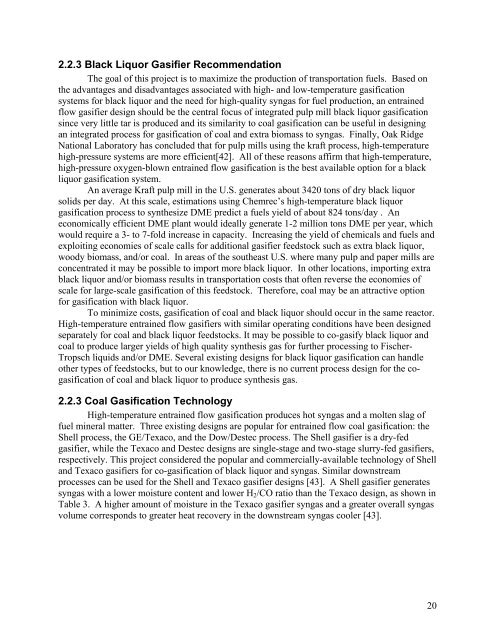Novel Design of an Integrated Pulp Mill Biorefinery for the ...
Novel Design of an Integrated Pulp Mill Biorefinery for the ...
Novel Design of an Integrated Pulp Mill Biorefinery for the ...
Create successful ePaper yourself
Turn your PDF publications into a flip-book with our unique Google optimized e-Paper software.
2.2.3 Black Liquor Gasifier Recommendation<br />
The goal <strong>of</strong> this project is to maximize <strong>the</strong> production <strong>of</strong> tr<strong>an</strong>sportation fuels. Based on<br />
<strong>the</strong> adv<strong>an</strong>tages <strong>an</strong>d disadv<strong>an</strong>tages associated with high- <strong>an</strong>d low-temperature gasification<br />
systems <strong>for</strong> black liquor <strong>an</strong>d <strong>the</strong> need <strong>for</strong> high-quality syngas <strong>for</strong> fuel production, <strong>an</strong> entrained<br />
flow gasifier design should be <strong>the</strong> central focus <strong>of</strong> integrated pulp mill black liquor gasification<br />
since very little tar is produced <strong>an</strong>d its similarity to coal gasification c<strong>an</strong> be useful in designing<br />
<strong>an</strong> integrated process <strong>for</strong> gasification <strong>of</strong> coal <strong>an</strong>d extra biomass to syngas. Finally, Oak Ridge<br />
National Laboratory has concluded that <strong>for</strong> pulp mills using <strong>the</strong> kraft process, high-temperature<br />
high-pressure systems are more efficient[42]. All <strong>of</strong> <strong>the</strong>se reasons affirm that high-temperature,<br />
high-pressure oxygen-blown entrained flow gasification is <strong>the</strong> best available option <strong>for</strong> a black<br />
liquor gasification system.<br />
An average Kraft pulp mill in <strong>the</strong> U.S. generates about 3420 tons <strong>of</strong> dry black liquor<br />
solids per day. At this scale, estimations using Chemrec’s high-temperature black liquor<br />
gasification process to syn<strong>the</strong>size DME predict a fuels yield <strong>of</strong> about 824 tons/day . An<br />
economically efficient DME pl<strong>an</strong>t would ideally generate 1-2 million tons DME per year, which<br />
would require a 3- to 7-fold increase in capacity. Increasing <strong>the</strong> yield <strong>of</strong> chemicals <strong>an</strong>d fuels <strong>an</strong>d<br />
exploiting economies <strong>of</strong> scale calls <strong>for</strong> additional gasifier feedstock such as extra black liquor,<br />
woody biomass, <strong>an</strong>d/or coal. In areas <strong>of</strong> <strong>the</strong> sou<strong>the</strong>ast U.S. where m<strong>an</strong>y pulp <strong>an</strong>d paper mills are<br />
concentrated it may be possible to import more black liquor. In o<strong>the</strong>r locations, importing extra<br />
black liquor <strong>an</strong>d/or biomass results in tr<strong>an</strong>sportation costs that <strong>of</strong>ten reverse <strong>the</strong> economies <strong>of</strong><br />
scale <strong>for</strong> large-scale gasification <strong>of</strong> this feedstock. There<strong>for</strong>e, coal may be <strong>an</strong> attractive option<br />
<strong>for</strong> gasification with black liquor.<br />
To minimize costs, gasification <strong>of</strong> coal <strong>an</strong>d black liquor should occur in <strong>the</strong> same reactor.<br />
High-temperature entrained flow gasifiers with similar operating conditions have been designed<br />
separately <strong>for</strong> coal <strong>an</strong>d black liquor feedstocks. It may be possible to co-gasify black liquor <strong>an</strong>d<br />
coal to produce larger yields <strong>of</strong> high quality syn<strong>the</strong>sis gas <strong>for</strong> fur<strong>the</strong>r processing to Fischer-<br />
Tropsch liquids <strong>an</strong>d/or DME. Several existing designs <strong>for</strong> black liquor gasification c<strong>an</strong> h<strong>an</strong>dle<br />
o<strong>the</strong>r types <strong>of</strong> feedstocks, but to our knowledge, <strong>the</strong>re is no current process design <strong>for</strong> <strong>the</strong> cogasification<br />
<strong>of</strong> coal <strong>an</strong>d black liquor to produce syn<strong>the</strong>sis gas.<br />
2.2.3 Coal Gasification Technology<br />
High-temperature entrained flow gasification produces hot syngas <strong>an</strong>d a molten slag <strong>of</strong><br />
fuel mineral matter. Three existing designs are popular <strong>for</strong> entrained flow coal gasification: <strong>the</strong><br />
Shell process, <strong>the</strong> GE/Texaco, <strong>an</strong>d <strong>the</strong> Dow/Destec process. The Shell gasifier is a dry-fed<br />
gasifier, while <strong>the</strong> Texaco <strong>an</strong>d Destec designs are single-stage <strong>an</strong>d two-stage slurry-fed gasifiers,<br />
respectively. This project considered <strong>the</strong> popular <strong>an</strong>d commercially-available technology <strong>of</strong> Shell<br />
<strong>an</strong>d Texaco gasifiers <strong>for</strong> co-gasification <strong>of</strong> black liquor <strong>an</strong>d syngas. Similar downstream<br />
processes c<strong>an</strong> be used <strong>for</strong> <strong>the</strong> Shell <strong>an</strong>d Texaco gasifier designs [43]. A Shell gasifier generates<br />
syngas with a lower moisture content <strong>an</strong>d lower H2/CO ratio th<strong>an</strong> <strong>the</strong> Texaco design, as shown in<br />
Table 3. A higher amount <strong>of</strong> moisture in <strong>the</strong> Texaco gasifier syngas <strong>an</strong>d a greater overall syngas<br />
volume corresponds to greater heat recovery in <strong>the</strong> downstream syngas cooler [43].<br />
20

















